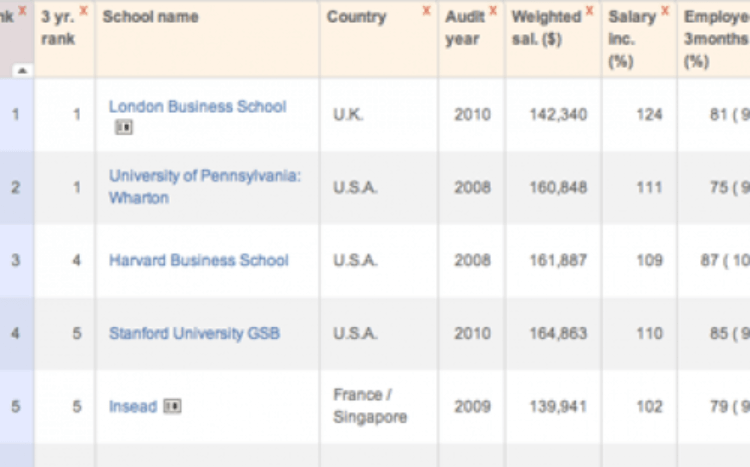Mixed results for Asian schools
The big winners in Asia undoubtedly were Hong Kong UST Business School, who will be celebrating their entry into the top 10, up from 16th a year ago. This is in stark contrast to CEIBS who dropped from 8th to 22nd, and NUS Business School fared even worse – falling from a respectable 35th place out of the rankings all together.
Fellow Singapore Business School Nanyang dropped a few places but remain a highly respectable 27th place. The Indian School of Business has continued to improve its position from its surprising debut of 20th two years ago, rising to 12th.
US schools still dominate...or do they?
While the rankings remain US-heavy with 56 schools were from the States this year, there might be cause for concern as over the past few years there has been a downward trend for the schools. The FT points out that in the first rankings 11 years ago, 20 of the top 25 schools were from the US; this has dropped to 11 this year, which could reflect the international mobility of students.
A more likely reason is the attractive 12-month MBA favoured by European schools – which are far more cost-effective in terms of affordability and return on investment than a traditional two-year programme in the States. Two US schools fell out of the rankings this year, two joined, and there were significant gains for Boston College (up 42 places to 47th), Purdue (up 26 to 54th) and George Washington University (up 28 to 57th).
Europe has its ups and downs too
Aside from LBS, there was good news for several UK schools, which was the second most represented country in the rankings, although only four made it into the top 25. This year, Saïd Business School rose four places to 16th, while Cranfield posted the biggest rise by a UK school in the top half, up 9 places to 26th. Imperial (32nd) also rose 7 places.
At the other end of the table Aston and Durham consolidated their places having entered the rankings in 2009. Cambridge (21st) Manchester (40th), Warwick (42nd), and Strathclyde (51st) all fell, but none more than Leeds University Business School, who like NUS were big casualties – falling from 57th last year to not being ranked this year.
The methodology – is it fair?
Each year these rankings cause much debate and navel-gazing for many business schools, particularly over sensitive issues such as the Purchase Power Parity index (PPP) that converts all salaries to US Dollars. Salaries play a huge part in the rankings – 40% weighting is given over to the salary today, weighted salary and salary percentage increase - and this does not necessarily favour all schools.
Indeed, there were only 7 new entries in the 2010 rankings (compared with 10 in 2009), showing that entry to this elite club is becoming increasingly difficult. The FT also points out that of the 156 schools who entered into the process, 48 did not meet the criteria, so really it’s the top 100 – out of only 108: harsh on those that just missed the cut.
There are also other criteria that heavily impact on certain schools, such as the minimum requirements to be ranked: at least 20 valid responses, or 20% of the cohort (whichever is the greater) means that larger schools, such as LBS with over 300 student intake back in 2006, would be able to fare much better than smaller schools who only have a pool of 50 from which to rely on responding to the FT survey.
The lack of response, or lack of quality from any given year, can make all the difference – the respondents from a small cohort may have gone into lower paid jobs, perhaps public sector rather than banking and finance, meaning the salary weighting is an issue. On the flip side, if the students come from a low salary (say, from the Indian sub-continent) and then move to Europe or the US to earn a much higher wage, this again makes a huge difference.
Global rankings – but how global are the schools?
Many feel that deciding factors in choosing an MBA, aside from the prospects at the end of study, are the networking opportunities and the mix of nationalities (hugely important to European schools). However, this doesn’t reflect in the rankings, as no US schools in the top 50 – and only two, excluding Hult, in the top 100 - reach even 50% international students, while ISB (3%) and Coppead (4%) are really only looking at home-grown students.
UK schools are the ones which have traditionally high percentages of international students, with 8 schools all having in excess of 90% international intake. However, these are all trumped by IMD in Switzerland, who can proudly boast 98% international students. On the whole, Europe steals a march on the US on this front, but as there is far more to the rankings than where the students originate, and most importantly salary, the US will forever dominate.
Rob Read is Founder and MD of Media Minds Global, an international marketing and communications agency specialising in education (www.mediamindsglobal.com)
RECAPTHA :
74
45
6f
25







